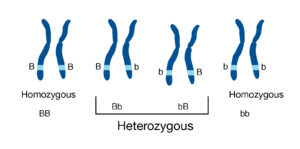HOMOZYGOUS AND HETEROZYGOUS
Introduction
In Biology and Genetics, Homozygous and heterozygous are used to indicate whether an individual has two of the same copies of a gene for a particular trait, or whether it has two different ones.
In other words, an organism that has the same two copies of a gene is considered homozygous for that trait, while an organism that has different copies of a gene for a particular trait is considered heterozygous for that trait.
Basically, heterozygous means different while homozygous means the same.
Let’s take an example for clear understanding-
Suppose one parent has black eye, and another has brown eye. One of their children get two copies of the black eye gene, while another child get one copy of the black eye gene and one copy of the brown eye gene. Here, the child with two copies of the gene for black eye is said to be homozygous, while the child with one of each is said to be heterozygous for the eye colour trait.
Homozygous and heterozygous are terms that are used to describe allele pairs. Individuals carrying two identical alleles (RR or rr) are known as homozygous. While individual bearing different alleles (Rr) are known as heterozygous.

Another way to understand the difference is to know the meaning of words-
‘Zygo’ meaning “yoke” or “yoked,” as in “paired together.” The suffix –ous is used to form adjectives. The difference is the Greek hetero– means “different,” and the Greek homo– means “same.”
Homozygous and heterozygous conditions help in determining dominant and recessive traits and inheritance pattern of genes.
What is a homozygote?
Homozygote refers to an organism with identical pairs of genes with respect to any given pair of hereditary traits, and therefore breeding true for that character.
So, homozygote is an organism that has two copies of the same allele for a particular trait.
Getting two parents that are homozygous for the trait ensures that it’ll be passed down, because there are no other copies of the allele in those genes other than the ones you want. This is useful for breeders of plants and animals.
What is a heterozygote?
A heterozygote is an organism that’s heterozygous for a particular trait.
Key differences between Homozygous and Heterozygous
Particulars Homozygous Heterozygous Meaning or Definition Homozygous is a genetic condition where an individual inherits the same alleles of a gene from both the parents. Heterozygous is a genetic condition where an individual inherits different alleles of a gene from the two parents. Genotypic Representation Homozygous genotypes are represented as AA or aa for homozygous-dominant or homozygous-recessive conditions, respectively. Heterozygous genotypes are represented by Aa genotypes. Occurrence Homozygous genotypes are observed in animals reproducing by asexual means. Heterozygous genotypes are mostly seen in animals reproducing by sexual means. Two different phenotypes are possible with dominant or recessive homozygous conditions. The phenotype is mostly due to the dominant allele in the heterozygous state. Types Homozygous-dominant and homozygous-recessive. The heterozygous condition can be expressed in three different ways; co-dominance, incomplete dominance, and complete dominance. Homozygote/Heterozygote Organisms or cells with the homozygous condition are termed as homozygotes. Organisms or cells with the heterozygous condition are termed as heterozygotes. Gametes Homozygous genotypes result in a single type of gamete. Heterozygous genotypes result in two different types of gametes. Traits Homozygous genotypes produce the same traits over different generations. Heterozygous genotypes produce different traits over different generations. The homozygous condition doesn’t show hybrid vigour. Heterozygous condition shows hybrid vigour. Self-fertilization Self-fertilization results in the repetition of the same traits over generations. Self-fertilization results in different combination of traits over the next generations. Disease Common diseases associated with the homozygous condition include fibrosis, sickle cell anemia, and phenylketonuria. Common diseases associated with the heterozygous condition include Huntington’s disease, Marfan’s syndrome, and familial hypercholesterolemia.